Geranium
Cranesbills, or hardy geraniums, are perennial members of the Geraniaceae family, one of many flowering genera within the family tree, which includes geraniums as well as close family members pelargonium and erodium.
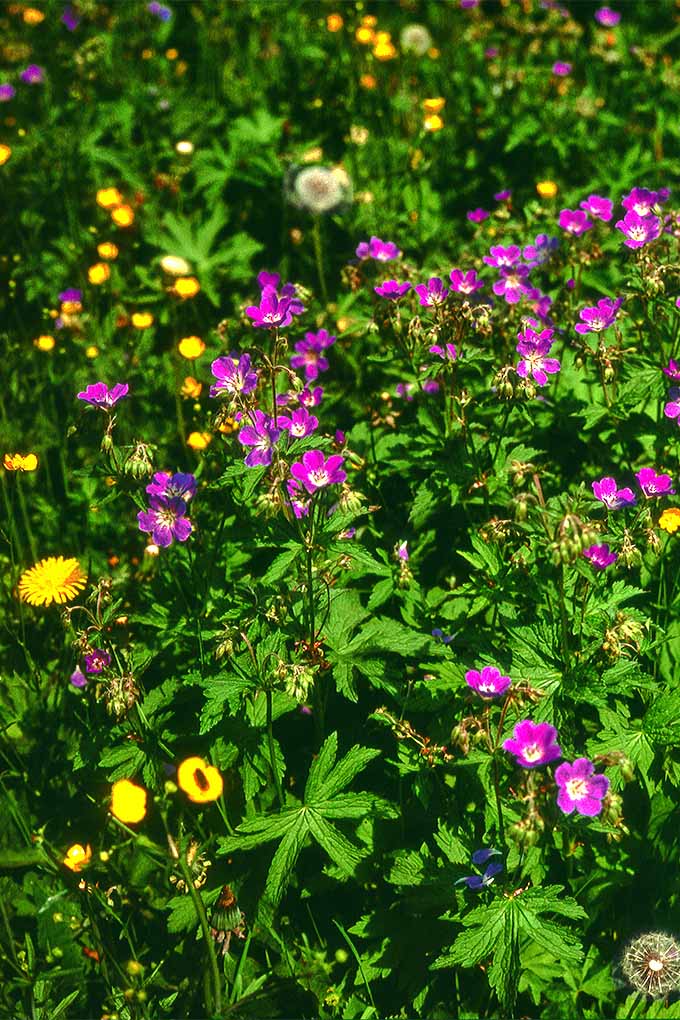
Native to temperate regions around the world, these cheery plants can be found nodding in mixed woodlands, meadows, prairies, alpine meadows, and rocky slopes.
With a particularly heavy population in the regions of the eastern Mediterranean, it’s no surprise that its name comes from the Greek geranos for crane. And cranesbill is Old English for the appearance of the long, beak-like fruit capsule that forms on some varieties.

A mounding plant, the dark green leaves have a light, citrusy fragrance and a broadly circular shape, with five-petaled flowers in shades of blue, pink, purple, and white.
By Any Other Name…
This hardy garden classic is not to be confused with pelargonium. A close cousin in the Geraniaceae family, many of us think pelargoinium is the bedding plant we call geranium; but cranesbills are the true species in the geranium genus.
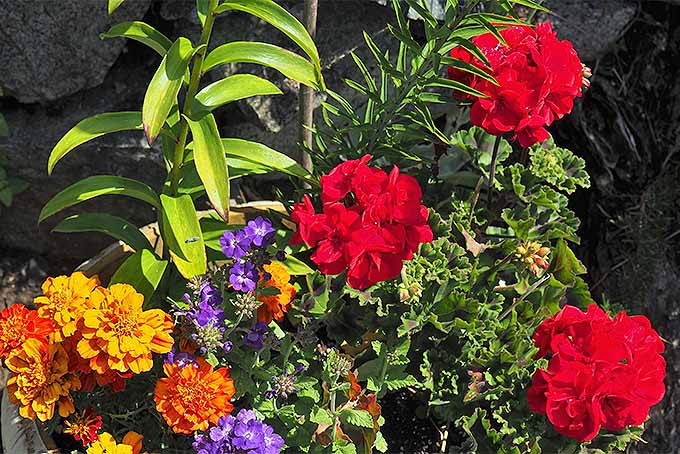
From the woodlands they call home, they’ve become residents of gardens worldwide, and prefer an environment similar to their original habitat.
This makes them ideal candidates for any areas that receive early morning sunlight with afternoon shade, or for areas with open shade from tall trees. And the can also grow under black walnuts and other juglone producing shrubs and trees.
Given the right conditions, these garden stalwarts will put on a low-key display of charming pastel beauty from spring until autumn. And many also offer a second season of interest with foliage in bold autumn colors of burnished bronzes, browns, reds, and yellows.
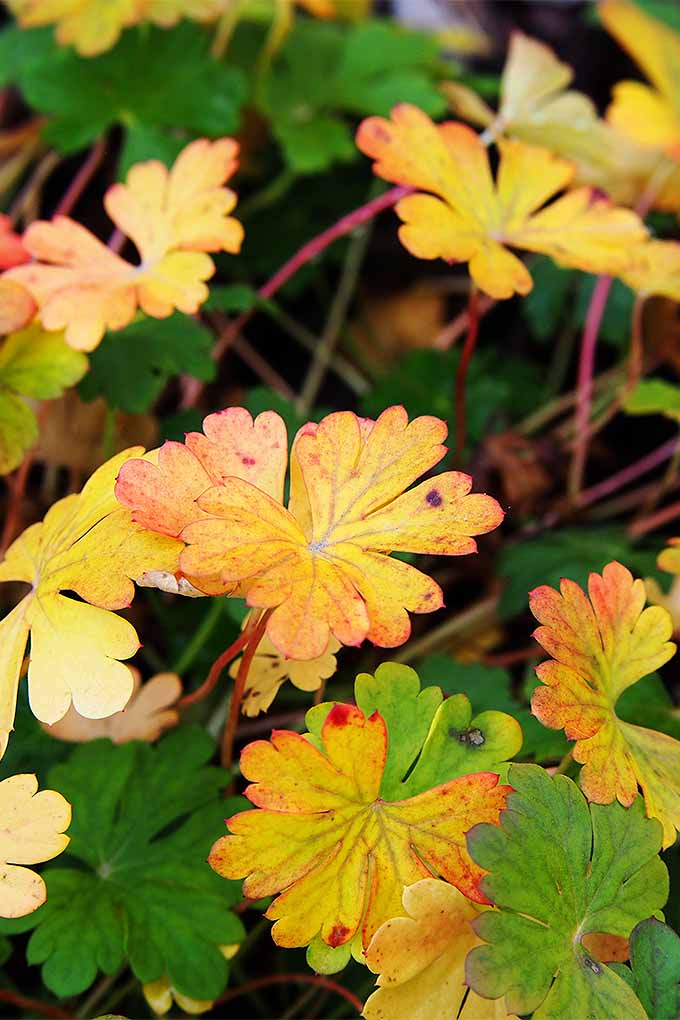
These aren’t the flashiest of plants, and you probably won’t use them as the focal point in a bedding area. But few other plants can fill the position of “best supporting perennial” as perfectly.
Cranesbill has the height to fill the second tier behind smaller border plants, and it’s a natural flanking taller shrubs. It can also be used successfully to fill in shady spots, for underplanting trees and rhododendrons, as an edging plant, and as a mainstay in naturalized settings with mixed wildflowers.
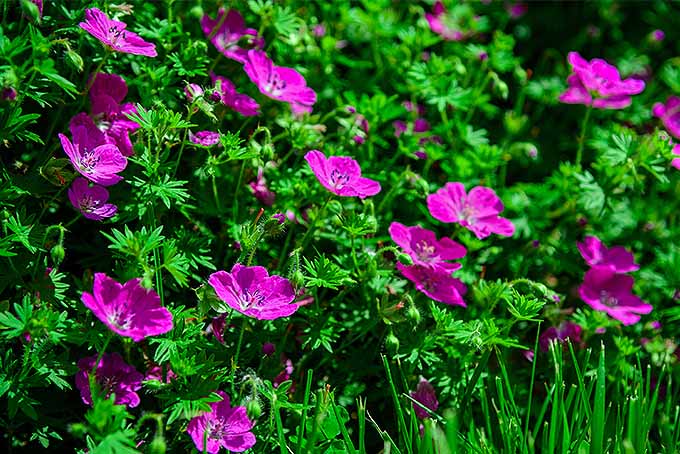
For natural areas, Geranium maculatum is a woodland geranium native to eastern North America, and G. pratense is a meadow species – with the double-flowered cultivar ‘Plenum violaceum’ receiving the Royal Horticulture Society’s coveted Award of Garden Merit (AGM).
Cranesbill geraniums also make a good camouflage plant for covering any low-lying eyesores. Their extensive growth can be slightly trained to hide offending material, but their soft form won’t cause damage, or make accessing the spot difficult.
Cultivars of the low-growing G. sanguineum, such as ‘Ankum’s Pride,’ grow with terrific vigor for filling in problem areas, and for use as a ground cover.

A welcoming plant for pollinators, they’re largely pest and disease free – however, on occasion, they will suffer from powdery mildew, leaf spot, or bouts of rust.
Should these problems arise, ensure the growing area has sufficient drainage – they don’t like roots standing in soggy soil. And provide adequate air circulation, as they like to feel a breeze on their cheeks!
Cultivation and Propagation
Carefree in growth, this pretty plant can handle almost any soil. It prefers earth that’s rich and loamy with humus, a bit on the moist side, with good drainage – not waterlogged or overly saturated.
Cranesbills thrive in the light shade that comes from high treetops, and will be most successful in locations that provide part shade or full morning sun.
A long-living perennial, growth is slow in the first couple of years. But once a mound is formed, these plants put on a show that lasts from late spring until autumn.
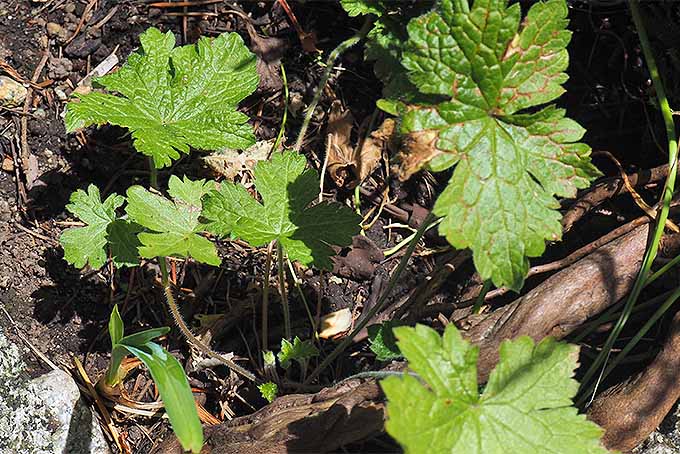
They also benefit from regular deadheading. By mid-summer, growth in some cultivars may be lagging – and your plump, pretty mound can look somewhat spent and leggy.
To rejuvenate, cut the mound back by one-half to encourage new flowers and prolong the season. Do this in one fell swoop, or shear two halves of the plant about two weeks apart to maintain some flowers while new growth forms.
Propagation may be done by collecting seed, stem rooting in water, semi-ripe wood cuttings in summer, or by root division in autumn or spring.
Collect seeds throughout the summer, then sow in spring or early summer for flowers the following summer.
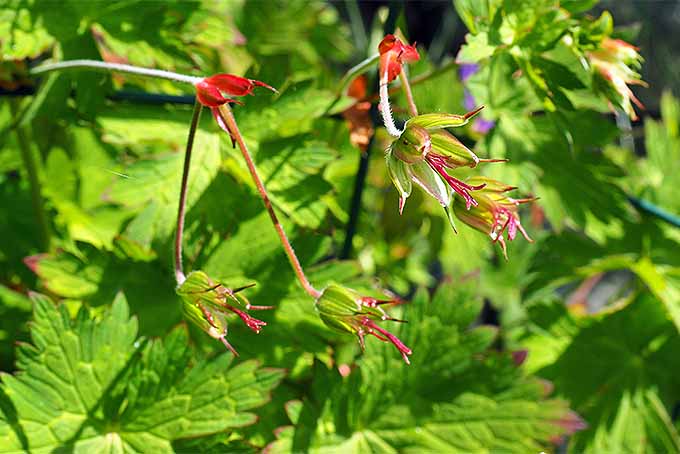
Deadheading keeps the plant compact, but you’ll also lose seedheads this way. If you intend to start plants from seed, allow some pods to remain on the plant to mature in place.
Stem rooting allows some plants to develop roots in water – and cranesbill is one of those plants.
Remember all those teacups with plant cuttings on your Gran’s windowsill? There’s a good chance they were geraniums!
For strong, healthy roots, use a sharp knife to cut the stem just below the node where leaves attach to the stem. Trim off the lower leaves, leaving the top two or three in place. Remove any flowers as well – energy needs to be directed to manufacturing roots, not seeds.
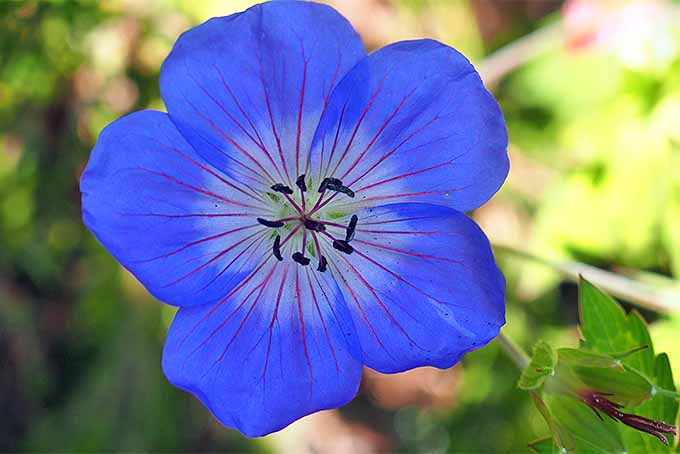
Place several cuttings in an opaque container of water, and change the water every few days or as needed. An opaque container helps to protect and shade delicate new roots, which usually form in 3-4 weeks.
Place the container, with cuttings, on a bright windowsill or in a sheltered spot in the garden that gets a few hours of gentle sunlight each day, anywhere from 2 to 6 hours. Morning light or dappled shade works best.
Once healthy roots develop to about 1-2 inches, plant as for stem cuttings below.
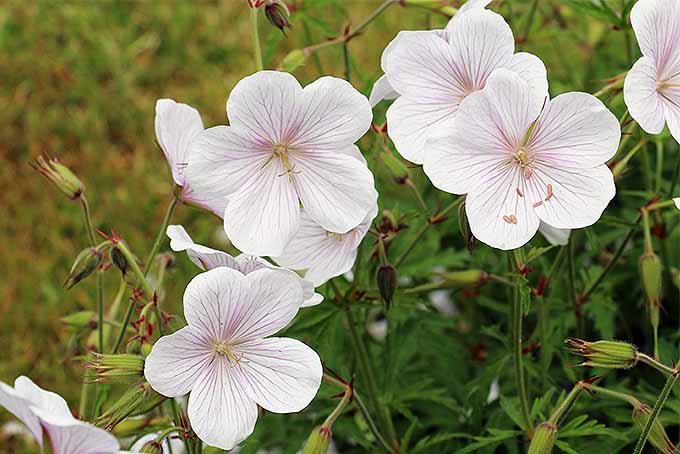
Semi-ripe wood is selected from this year’s growth. The base of the cuttings will be older and hard, while the tip is still tender and green. Semi-ripe wood can be collected anytime from mid- summer until mid-autumn.
Place stem cuttings and root divisions in small pots with a light, sandy potting mix. You can also tuck them into a nursery bed for 1 to 2 years, or until they are mature enough to go into the ground.
Nurturing Nature
For a flowering perennial, a balanced fertilizer of 10-20-10 can be applied in early spring, just as new foliage begins to show.
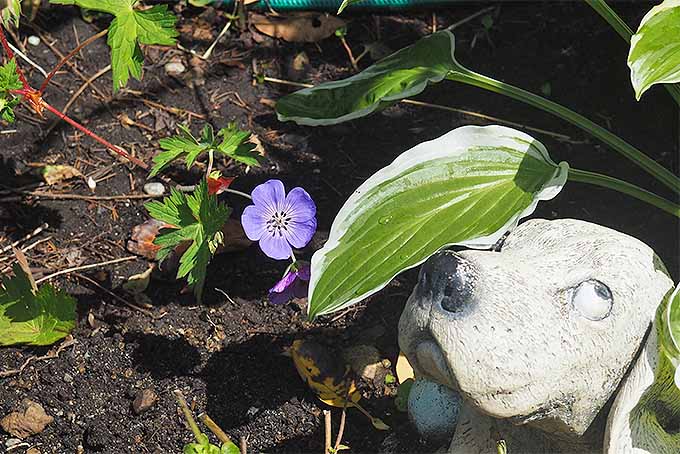
And if your plant gets a good shearing in mid-summer, re-apply the fertilizer just as new growth begins to emerge.
As with most plants that enjoy some shade and moist soil, avoid over-fertilizing, as this is a main cause of sprawling, lanky growth.
Geranium Plant Facts
- Prefer light shade for best growth and flower production.
- A moist soil rich in humus is their growing medium of choice.
- Once established, they require little care outside of regular watering.
- Reliably winter hardy in Zones 4-9
- Annual growth 12-20 inches in height, with a spread of 18-24 inches.
- Seeds can be started in spring or summer for flowers the following summer.
- Many varieties have handsome autumn foliage.
- Will die back in winter.
Where To Buy
You can buy the top-performing ‘Rozanne’ variety online.
Named the Royal Horticulture Society’s “Plant of the Centenary,” it’s available from Nature Hills Nursery in 5-inch pots.
No-Fuss Blooms
The cranesbill geranium is everything we love in hardworking perennials!
Care and feeding requirements are simple, it works in multiple garden locations, and it reliably puts on a show of sweetly colored blossoms all summer long.
Just give it regular water, some afternoon shade, and a good shearing if it gets a bit too leggy. Other than that, this hardy plant stands on its own – making it a welcome addition to any garden!
What about you readers, any questions about the cranesbill you’d like answered? Drop us a line in the comments below.
And for more info on growing geraniums, be sure to check out some of our other guides:
- How to Grow and Care for Garden Geraniums
- How to Grow Ivy Geranium: the Queen of Hanging Baskets
- How to Plant and Grow Scented Geraniums
- Are Geraniums Annuals or Perennials? Learn About Geranium Lifespans
Photos by Lorna Kring, © Ask the Experts, LLC. ALL RIGHTS RESERVED. See our TOS for more details. Product photo via Nature Hills Nursery. Uncredited photos: Shutterstock.
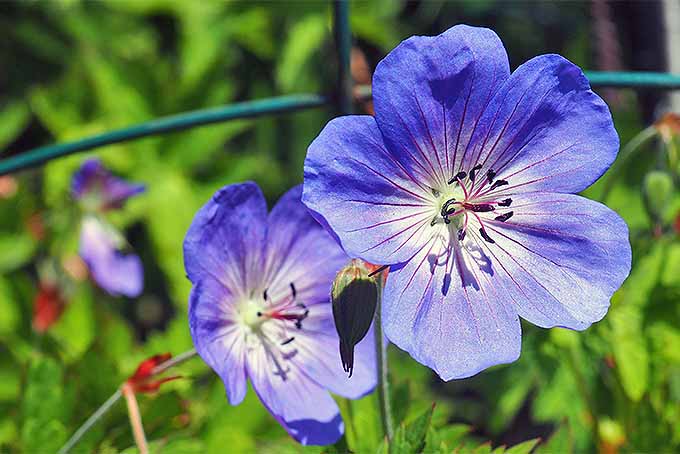
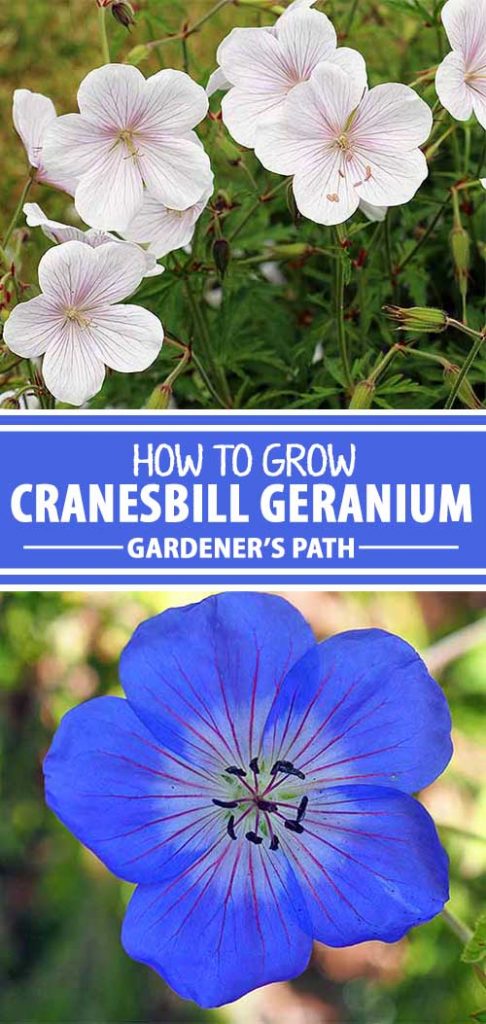


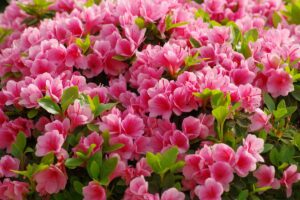
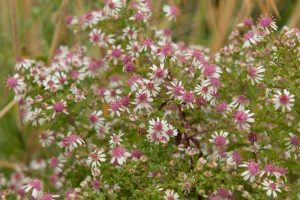
My cranesbill leaves turn brown after spring flowering. Should I move to a shady location? How can I get them to flower all summer?
They prefer afternoon shade Evelyn, so moving them might help if they’re getting blasted with hot sun. Try cutting them back lightly (no more than 1/4 of total growth) after spring flowering, and give them regular doses of a 20-20-20 all purpose fertilizer throughout the growing season – that should help produce a few more blooms. Thanks for asking!
Hi Lorna, Thank you for your sharing your knowledge on the hardy geranium. I purchased 6 of the Rozanne variety last year to line my walk. . They did great through the summer and fall. This spring I waited to see them come up again. Sadly only 1 returned after winter. I did nothing to them after their growing season ended. Should I have cut them back right before winter? They were expensive and I hesitate to purchase 5 more to replace the ones I lost especially if something I did wrong caused them to die. I am planning to… Read more »
Your Rozanne sounds like it should be a better performer Doreen. A couple of things I can think of… they need good drainage, and sitting in water over the winter could cause root collapse.
The other thought is to ensure the plant’s crown is planted deep enough to withstand freezing temperatures. – a thick winter mulch, 4-6 inches deep will help with this. And no need to cut them back at the end of the season, they’ll die back on their own. Hope this helps, and good luck with your cuttings!
I just received some cranesbill geranium from a friend. When planting, should I cut the top growth to encourage strong roots?
Spot on Barb! I’d trim back about one-third and add a nice topdressing of compost. A mid-summer trim will encourage more blooms too!
Thanks for your question!
Hi, Mine seem to spread beautifully but I only get one or two flowers. It looks healthy and keeps spreading but no flowers. Any idea why?
Lots of plants will respond to too much nitrogen in the soil by leafing out but failing to flower. Are you fertilizing your plants?
I was at a garden center where a beautiful geranium was growing up through a crack in the sidewalk. I was offered the opportunity to take seeds, which I did. My question is, should I plant the seeds now or wait and plant them in the spring and be able to take a year before they bloom? The owner of the garden center said she thought it was a perennial geranium. It had that kind of a bloom, and kind of an ivy geranium leaf.
What a lucky find, Ellen! Geranium seedlings tend to grow slowly. Save them in an envelope in a cool, dry place for now, and plant them indoors in February in a warm and sunny location, or under grow lights on a heating mat. Some types will germinate in just a few days while others may take a month or so- be patient! Plan to transplant them outdoors or transfer them to pots in a sunny location, hardening them off gradually after the threat of frost has passed.
Good luck! Let us know how it goes!
Cranesbill Geranium, Do seeds need a cold season to germinate? When starting seeds indoors, do seeds need to be scratched to promote germination? I have tried to cultivate indoors from seed in early spring without success.
The seeds don’t require any special treatment to germinate Norine, but I suspect you may have collected seed from a sterile hybrid. Plants of this nature need to be propagated vegetatively, with root divisions or stem cuttings – both of which are easy and reliable with geraniums.
Thanks for your question!
Hello Lorna. Hope you are well. I recently bought ‘PATRICIA’ cranesbill in memory of my dear mom who passed away in May this year. They were plug plants and we left them in bigger pots before planting them out under a rose. The one plant has flowered well but the flowers are wilting now the other 2 failed to flower. The leaves are very leggy. Any advise please. Blessings to you x
‘Patricia’ makes a lovely tribute to your mom Teresa, such a pretty color! Cranesbill can take a year or two to really hit their stride, so new plants with low flower count might just be ‘late bloomers’ – production should improve next year. As the growing season wears on they can become leggy and benefit from a good pruning around mid-summer. Cut back by as much as half to encourage new growth and blooms. Also, ensure the soil is consistently moist and avoid over-fertilizing, which can cause them to sprawl. A single application of a slow-release, 10-20-10 fertilizer in spring… Read more »
Thank you and blessings to you x
Hello Lorna, We purchased a new home last summer and there is an over abundance of NH Cranesbill on the property. Pretty much the backyard is a field of it. It is thriving and has been well established here for years. I want to relocate some of it and give some away to neighbors and friends. Would a sod cutter work to transplant large patches or do you recommend repotting and distributing in this way? There is so much of it that it seems I could take it in small squares or sheets to transplant. I am excited to see… Read more »
I like your idea of cutting out squares or sheets to transplant, Brenda. It would certainly be a lot less labor-intensive than lifting and repotting individual plants. This would work well for the masses of plants you describe, and you should be able to lift enough of the roots with a sod cutter or shovel to move them successfully. Try lifting and relocating half a dozen or so sections this spring – if you’re happy with the results, you can move more at the end of summer. If not, it’s back to repotting. Thanks for you question, and let us… Read more »
I bought some geranium Roseanne for my back yard to plant along my garage, but the front of my house has a red theme and was wondering if they have a red geranium I could purchase that will return yearly as well? Any suggestions? Thanks, Tom
Unfortunately, there are no true red ones that I know of, Tom.
There are plenty of magentas and several in shades of bright pink… what about white or a very pale pink?
G. cantabrigiense ‘Biokovo’ is a very light blush color and G. ‘Spessart’ has white petals – could look very nice against the red!
Thanks for your question, and let us know what you decide on!
Are there any Cranesbill’s that bloom 2 or 3 times a year? Thanks Sharon
Hi Sharon, there are no “repeat blooming” cultivars that I’m aware of.
However, with regular deadheading and cutting back leggy growth, many of the popular cultivars provide months of flowers from spring until frost.
‘Ann Folkard’, ‘Ballerina’, ‘Mavis Simpson’, ‘Patricia’, and ‘Rozanne’ are a few award-winning cultivars noted for their outstanding displays and long flowering seasons.
Thanks for asking!
Hi Lorna, I have a cranesbill for several years now. When I first planted it it had beautiful purple flowers however this year the flowers came in white. Is this a ph problem?
Unlike hydrangeas, geraniums do not change color based on the pH level of the soil. Did the flowers that had white blooms this year grow from seed? Hybrid cultivars do not produce seeds with the same qualities of the original parent plant, so this may be what happened here.